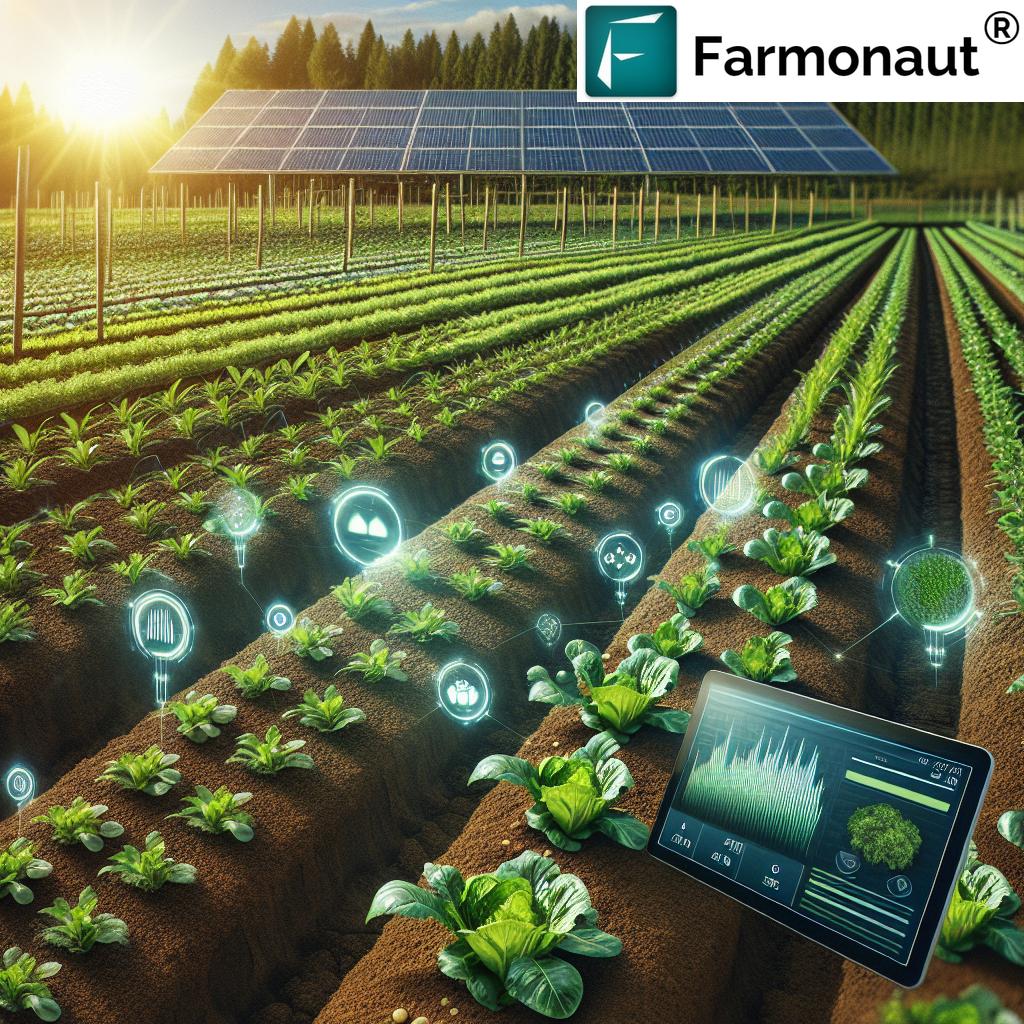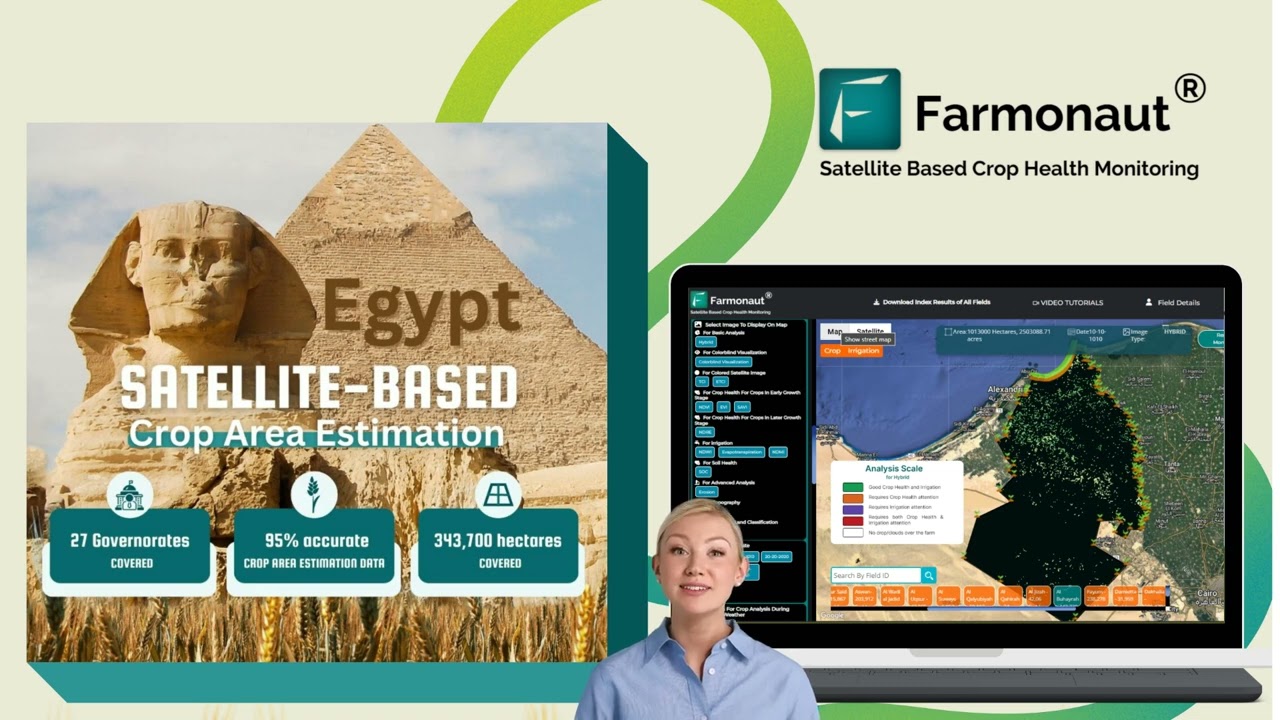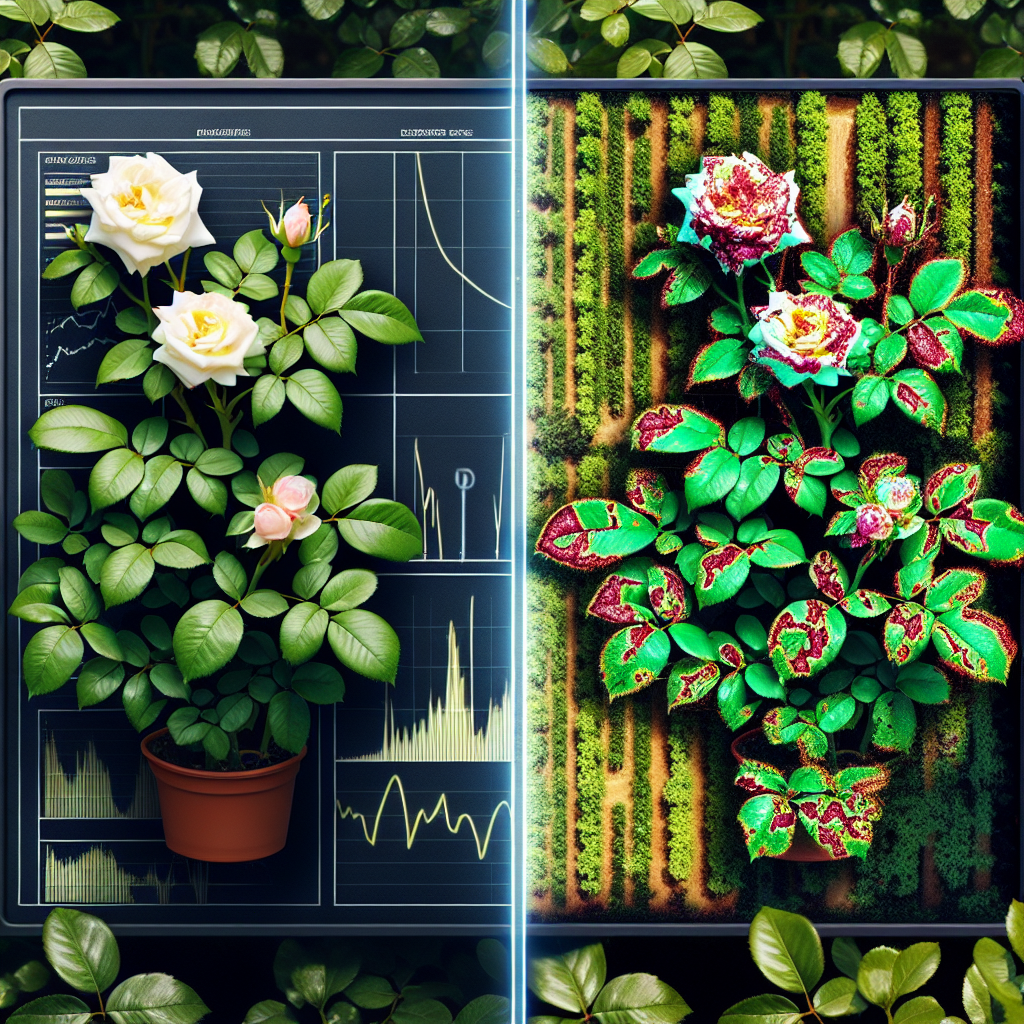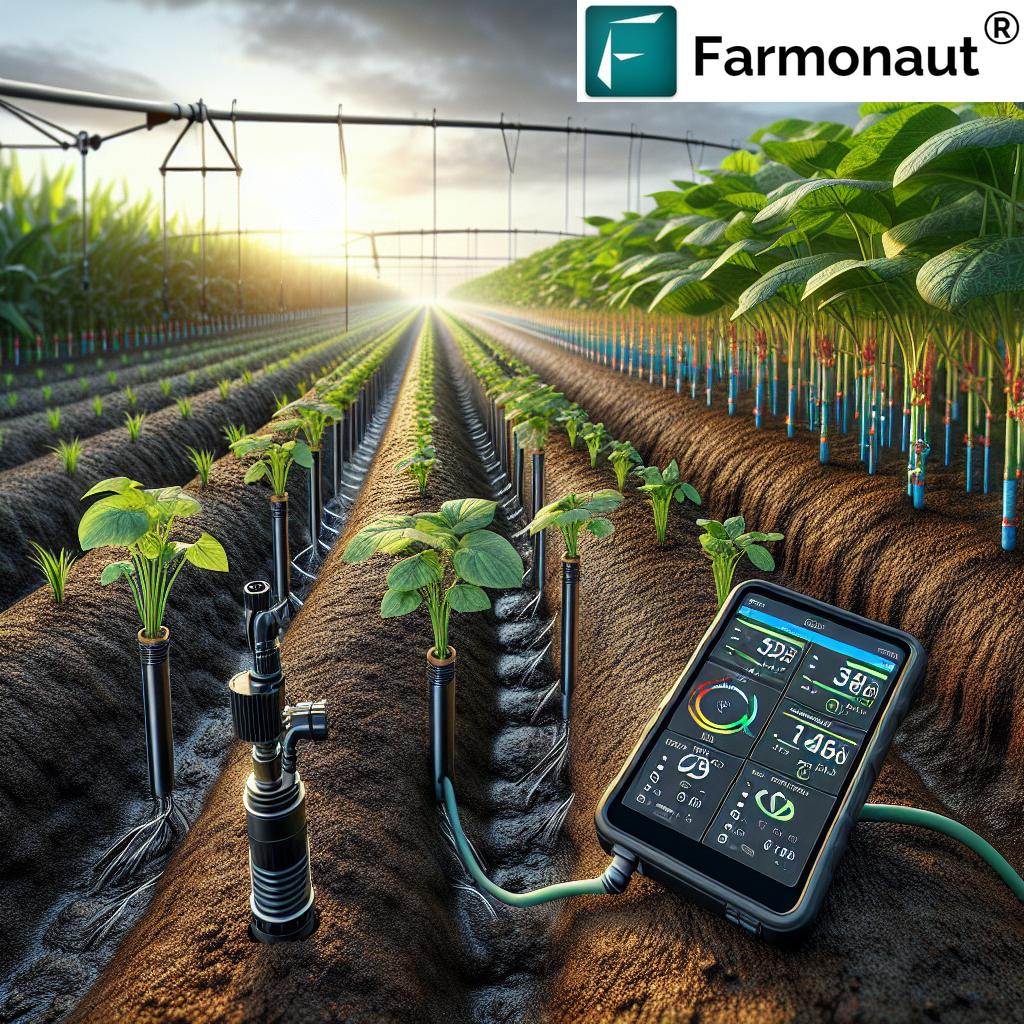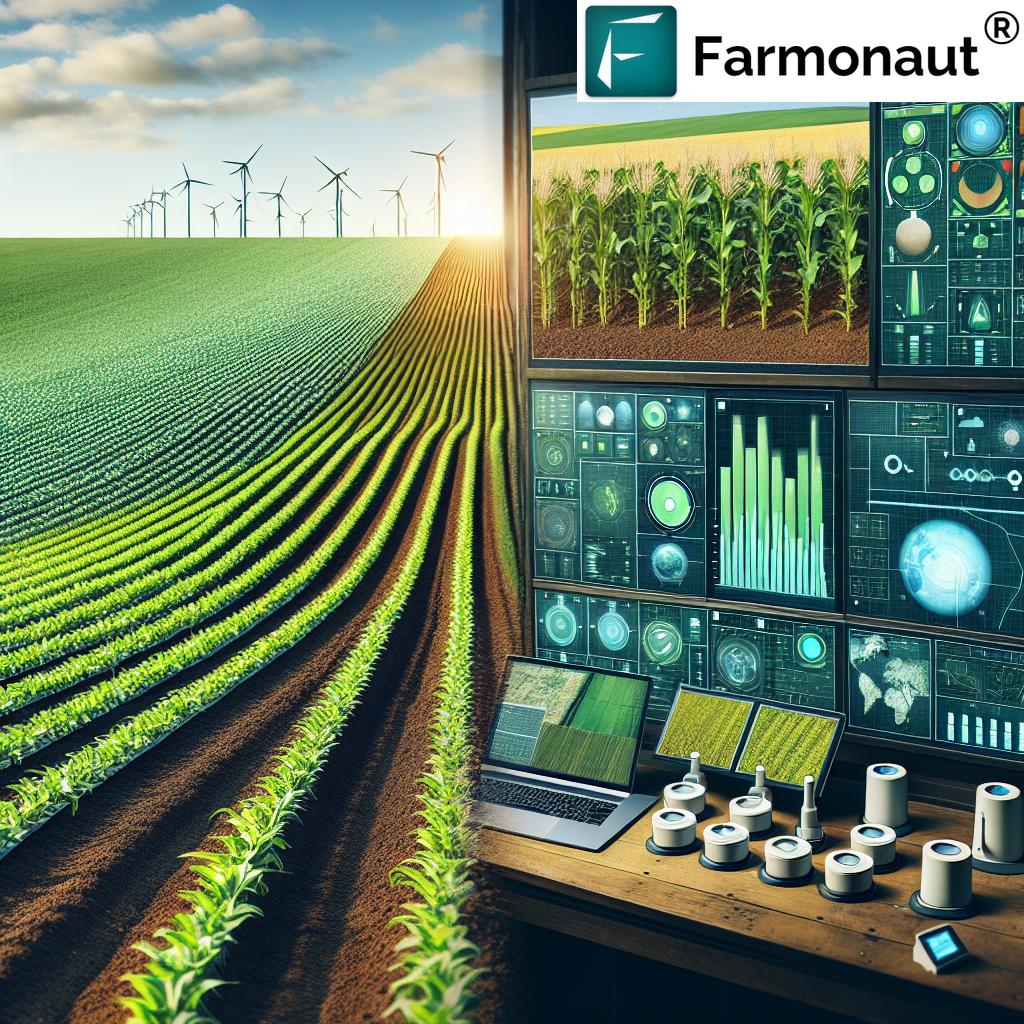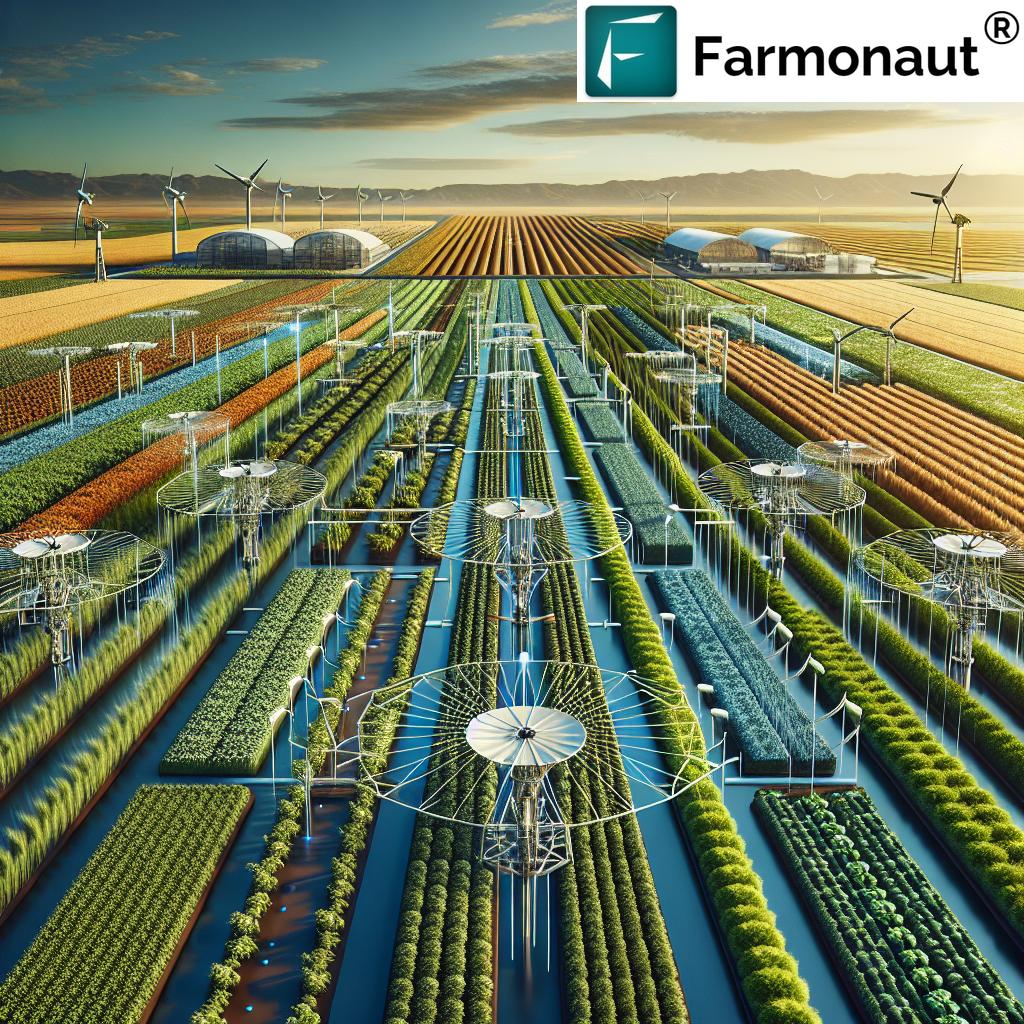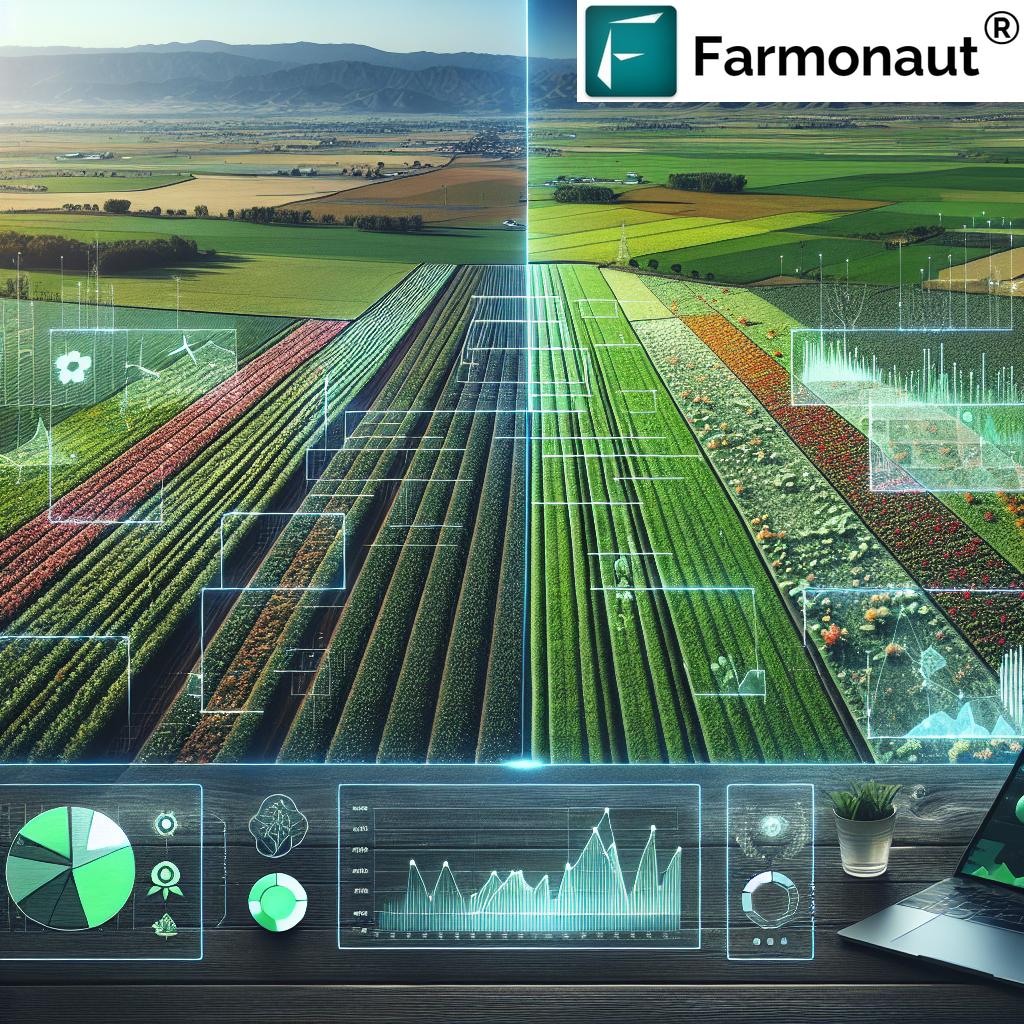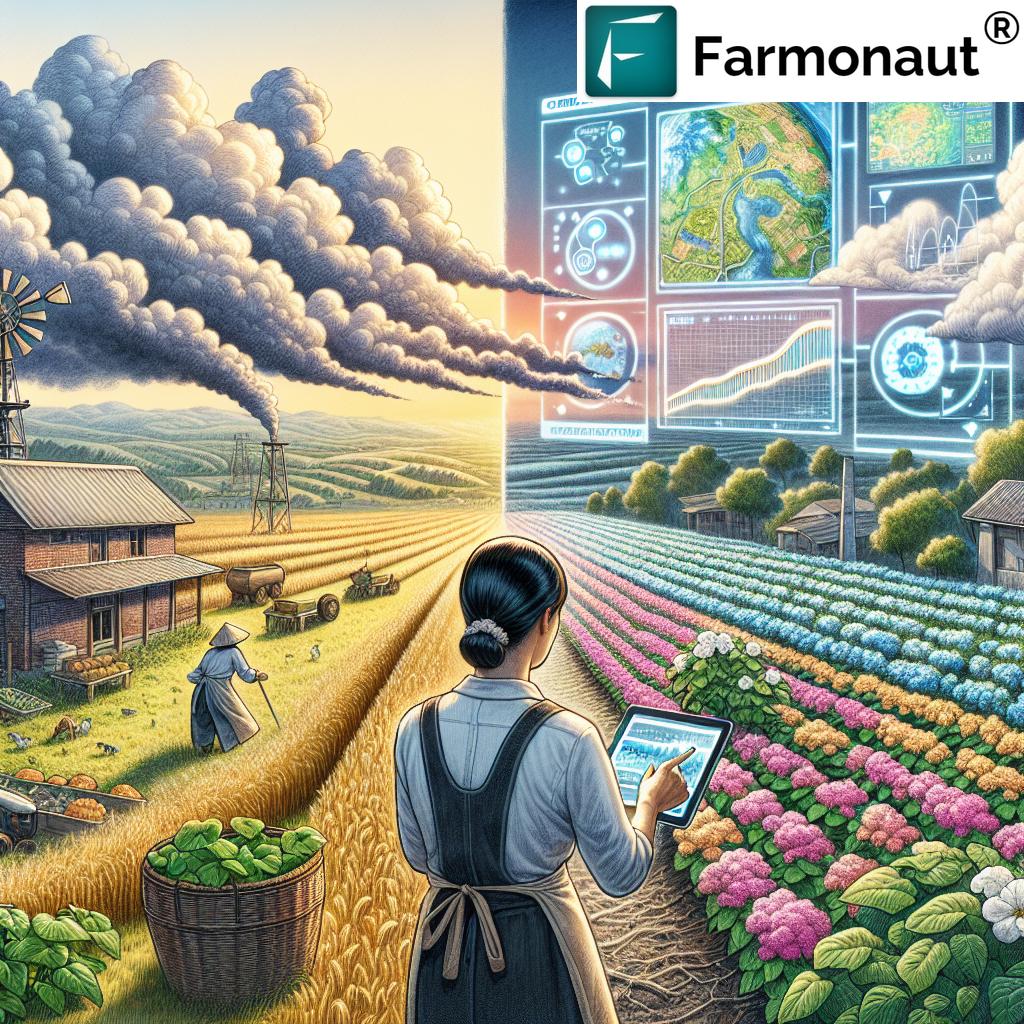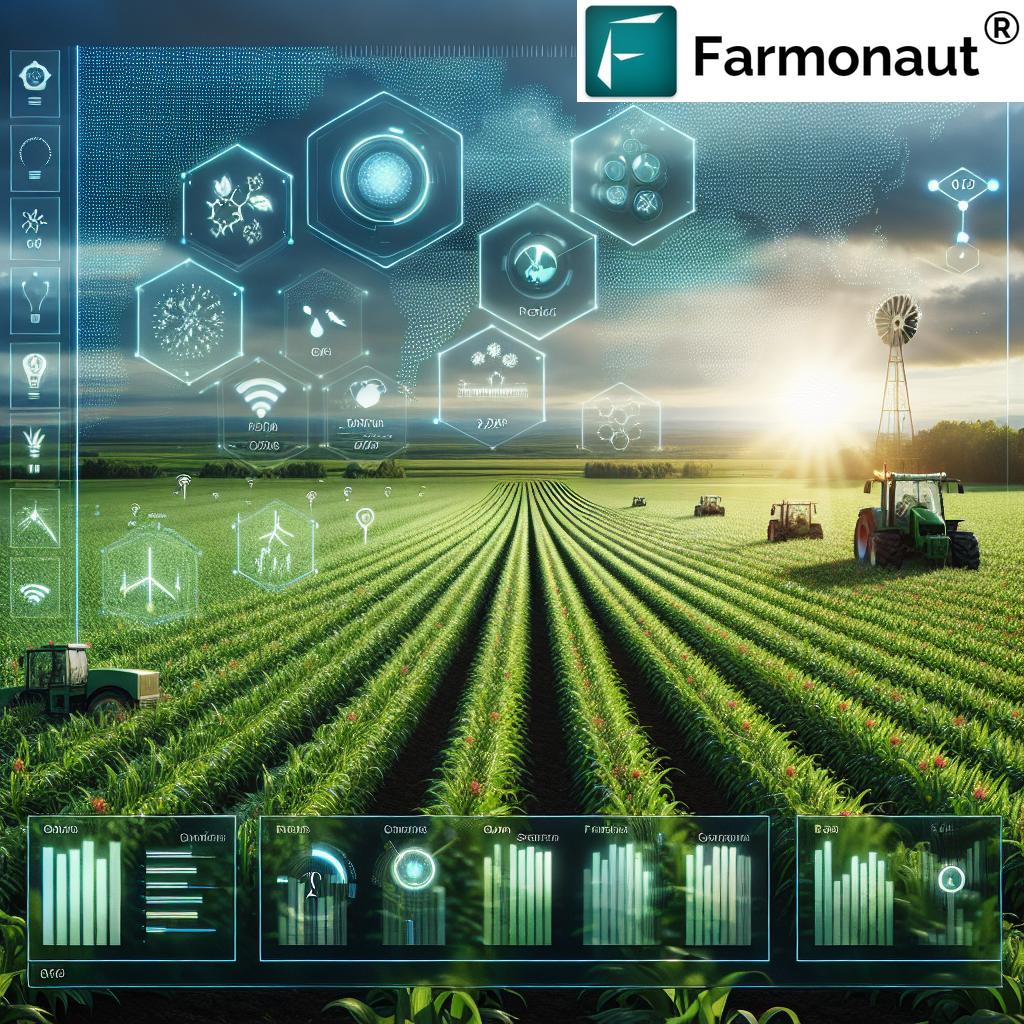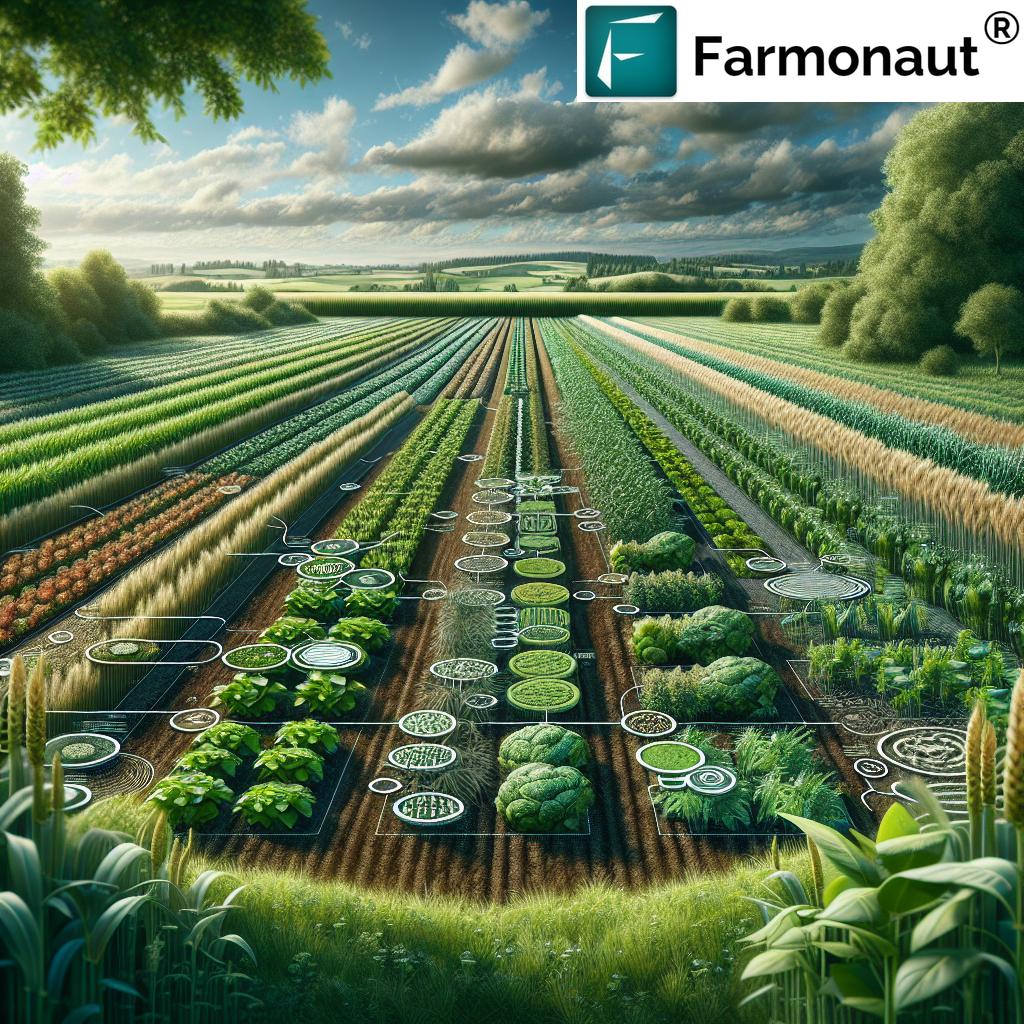Sustainable Farm Tech: 10 Innovations for Greener Ag
Table of Contents
- Introduction: The Future of Sustainable Agriculture
- Comparative Impact Table: Sustainable Farm Innovations
- 10 Innovations Driving Greener Ag
- 1. Precision Agriculture
- 2. Vertical Farming Methods
- 3. Hydroponics and Aquaponics Systems
- 4. Agroforestry Practices
- 5. Smart Irrigation Solutions
- 6. Renewable Energy Integration
- 7. Biological Pest Control
- 8. Monitoring Soil Health
- 9. Silvopasture Systems
- 10. Artificial Intelligence in Agriculture
- Beyond the Top 10: Emerging Sustainable Farming Technologies
- Blockchain in Agriculture Supply Chain
- Carbon Farming Practices
- Nanotechnology and Nano Sensors in Agriculture
- Regenerative and Biointensive Farming Techniques
- Farmonaut: Advancing Sustainable Agriculture with Technology
- Frequently Asked Questions
- Conclusion
“Precision irrigation can reduce water usage by up to 50% compared to traditional methods, boosting sustainability in agriculture.”
Introduction: The Future of Sustainable Agriculture
As the 21st century brings intense environmental challenges and a rapidly growing global population, sustainable agriculture is at the forefront of ensuring food security, resource conservation, and ecological balance. Sustainable farm technology encompasses a vast range of innovative practices and advanced tools, all designed to enhance agricultural productivity while minimizing environmental impact. By integrating advanced technologies—from precision farming to blockchain-based transparency—with holistic ecological principles, modern farming systems can optimize soil health, water use, crop yields, carbon sequestration, and overall resource efficiency. This revolution in farming is driven not only by rapid technological advancement but also by a deep commitment to restoring and protecting our planet’s delicate ecosystem.
In this comprehensive guide, we’ll explore 10 of the most impactful innovations for greener agriculture—demonstrating how digital transformation, data-driven insights, and sustainability-driven interventions are shaping the future of resilient, eco-friendly farming systems worldwide.
Comparative Impact Table: Sustainable Farm Innovations
To help you quickly compare the top sustainable farm technologies, we’ve compiled a data-driven overview. This table highlights each innovation’s core features, environmental benefits, estimated water savings and yield increase, and indicative adoption cost per acre.
*Costs and yield increases can vary significantly by region, crop, and scale of vertical systems. Figures are estimates & range based on current available data.
All impact and cost values in the table are indicative, derived from published research and ongoing field observations for sustainable agriculture.
10 Innovations Driving Greener Ag
1. Precision Agriculture: Optimizing Every Acre
Precision agriculture is a transformative approach that utilizes advanced GPS, sensors, and data analytics to optimize every aspect of agricultural production. This method enables farmers to monitor soil health, assess plant nutrient levels, and detect pests and diseases early. By employing site-specific interventions, farmers can apply water, fertilizers, and pesticides precisely where needed, drastically reducing resource waste, limiting environmental pollution, and maximizing yields.
- Technologies used: Remote sensors for moisture and nutrient detection, multispectral imaging, yield mapping, GPS-equipped machinery.
- Benefits: Improves sustainability by minimizing excess application of water and chemicals and reducing operational costs.
- Applications: Variable-rate fertilizer application, targeted irrigation, weed/pest mapping, and automated farm machinery guidance.
Farmonaut makes these advanced precision farming technologies accessible globally. Using satellite data, our platform enables real-time crop health monitoring, AI-advisory systems, and more, helping farmers optimize inputs and maximize environmental benefits.
Discover Farmonaut’s Precision Solutions or try our Large-Scale Farm Management Platform for advanced monitoring and analytics.
2. Vertical Farming Methods: Growing Upwards, Not Outwards
Vertical farming redefines urban and rural agriculture by growing crops in vertically stacked layers, often in indoor, controlled environments. By leveraging technologies such as LED lighting, hydroponics, and automation, these systems allow year-round cultivation, maximizing land use efficiency and conserving water. Since these farms are isolated from most outdoor pests and variable weather conditions, the reliance on synthetic pesticides and fertilizers is also greatly reduced.
- Benefits: Up to 90% less water use, reduced need for land, higher crop densities, significant yield improvements, and minimal environmental pollution.
- Operation: Often uses hydroponics or aeroponics, whereby nutrient-rich mist or water supports plant growth without soil.
- Use Cases: Urban food production, desert agriculture, and climate-resilient crop cultivation in cities prone to food insecurity.
Example: Leafy greens, strawberries, and herbs thrive in controlled vertical systems, allowing for local, fresh produce distribution and reduced food miles.
Related Farmonaut Video:
“Cover cropping increases soil organic matter by 15-30%, enhancing soil health and crop resilience in sustainable farming systems.”
3. Hydroponics and Aquaponics Systems: Soilless & Symbiotic Farming
Hydroponics enables plants to grow without soil, using nutrient-rich water solutions. This approach realizes precise nutrient management, conserves water, and supports rapid plant growth for higher yields.
- System Types: NFT (Nutrient Film Technique), deep water culture, and drip hydroponics.
- Benefits: Reduces water use by 70-90%, enables year-round production, and mitigates soil-borne diseases.
In aquaponics, hydroponics merges with aquaculture: fish waste provides nutrients for plants, while plants cleanse the water for the fish. This closed-loop system is the epitome of ecological sustainability.
- Advantages: Recycles nutrients, reduces fertilizer input, and produces two products (fish and crops) with fewer resources and less waste.
- Environmental Impact: Lowers water use and enhances nutrient efficiency, key for sustainable agriculture in arid climates or urban areas.
4. Agroforestry Practices: Integrating Trees for Multifunctional Farms
Agroforestry is the practice of integrating trees and shrubs into agricultural land, creating diverse, multi-layered systems that offer a wealth of benefits:
- Biodiversity: Provides habitats for pollinators and beneficial wildlife, boosting farm ecosystem health.
- Soil Improvements: Trees offer organic matter, reduce runoff and erosion, and increase carbon sequestration.
- Shade and Shelter: Helps mitigate heat stress, reduces moisture loss, and protects sensitive crops.
- Income Streams: Timber, fruit, nuts, and sustainable forestry coexist with traditional crops.
Example: Coffee and cacao cultivated beneath shade trees show improved resilience to changing weather and pests, while supporting higher bird and insect diversity.
5. Smart Irrigation Solutions: Conserving Water, Enhancing Yields
Smart irrigation takes irrigation efficiency to the next level, harnessing sensors and weather data to deliver water based on real-time crop and soil needs. By automating watering schedules and adjusting to weather conditions, these systems ensure plants receive exactly what they need, reducing water waste and curbing energy consumption.
- Technologies: IoT soil moisture sensors, weather-linked controllers, satellite data analytics.
- Benefits: Reduces water consumption by up to 50%, lowers energy bills, prevents leaching and runoff, supports sustainable agriculture in water-scarce regions.
On the Farmonaut platform, growers gain access to advanced smart irrigation tools powered by satellite insights—empowering data-driven decisions for optimal soil and crop health, even when farming at scale.
Try our web and mobile apps to explore smart irrigation and farm management features:



6. Renewable Energy Integration: Harvesting Sun and Wind for Greener Farms
Renewable energy integration dramatically lowers a farm’s carbon footprint by replacing fossil fuels with solar panels, wind turbines, and innovative approaches like agrivoltaics—the installation of solar arrays over cropland. This intelligently designed synergy generates clean electricity while also providing partial shade for plants, reducing heat stress, slowing evaporation, and boosting overall resilience.
- Environmental Impact: Decreases emissions, provides opportunities for “dual land use”, and enables self-sufficiency, especially in rural and off-grid communities.
- Financial Benefits: Reduces utility costs and may offer new revenue streams by feeding surplus energy back to the grid.
Key Adoption: Combining solar with smart irrigation and precision agriculture for truly integrated, sustainable farming systems.
Related Farmonaut Feature: Our Carbon Footprinting platform helps track, monitor, and reduce your environmental impact across your agricultural operations, aligning with climate goals and regulatory compliance.
7. Biological Pest Control: Enhancing Balance with Nature
Biological pest control replaces or supplements synthetic chemical pesticides with natural enemies—including predatory insects, parasitoids, and microbial agents. This method restores and maintains ecological balance in farming systems, enhancing biodiversity and boosting the long-term resilience and productivity of crops.
- Examples: Ladybugs released to feed on aphids, nematodes deployed to disrupt pest larvae, and Trichogramma wasps controlling caterpillars.
- Advantages: Reduces resistance build-up, improves pollinator populations, and supports sustainable agricultural practices.
- Best For: Organic, regenerative, and integrated pest management (IPM) systems.
8. Monitoring Soil Health: Data-Driven Regeneration
Soil health monitoring leverages advanced sensors, satellite imagery, and data analytics to measure soil composition, pH, nutrient content, and moisture levels. By understanding these dynamics in real-time, farmers gain insights to optimize fertilization, crop rotation, and irrigation—ultimately enhancing soil fertility over time.
- Technologies: IoT-enabled nano sensors, remote satellite data, digital soil mapping, AI-based diagnostics.
- Outcomes: Increased yield, improved resource use efficiency, minimized risk of soil degradation, and strong environmental stewardship.
We at Farmonaut offer real-time soil and crop health monitoring via multispectral satellite analysis and analytics, readily accessible on Android, iOS, web, and API. Our data empowers farmers worldwide to take precise, timely interventions for better sustainability and higher yields.
9. Silvopasture Systems: Trees & Livestock in Harmony
Silvopasture is the strategic integration of trees or shrubs with livestock grazing. By providing shade and shelter, this system ensures animal welfare, improved pasture productivity, erosion control, and additional income avenues through timber or fruit harvests.
- Ecosystem Benefits: Enhances carbon sequestration, reduces dust and wind erosion, and increases overall biodiversity on the farm.
- Productivity: Livestock thrive with more consistent body temperatures, while forages under trees often have greater moisture and nutritional value.
Example: Rotationally grazed cattle in oak or walnut groves reap both animal and long-term tree-based returns while regenerating the soil.
For crop-forestry integration advice, explore our Plantation & Forestry Advisory Services.
10. Artificial Intelligence in Agriculture: Data, Prediction, and Automation
Artificial intelligence (AI) and machine learning analyze vast and complex sets of data to optimize entire farming systems. By processing signals from satellites, sensors, weather, market trends, and past performance, AI-driven platforms:
- Predict optimal planting schedules based on soil and climate data.
- Detect diseases and pests early via anomaly detection in imagery or sensor readings.
- Automate irrigation and fertilization schedules for maximum efficiency, minimal waste, and sustainable productivity.
- Identify resource inefficiencies and recommend targeted interventions.
At Farmonaut, AI is at the heart of our platform: our Jeevn AI advisory tool delivers real-time, location-specific, and crop-tailored guidance to boost yields and minimize environmental impact.
For API access and integration of AI-driven agricultural solutions, developers can visit our API and browse the Developer Docs.
Beyond the Top 10: Emerging Sustainable Farming Technologies
The sustainable agriculture revolution doesn’t stop here. Powerful new innovations are transforming farming systems—strengthening food security, reducing carbon emissions, and fostering farm-to-table traceability.
Blockchain in Agriculture Supply Chain: Ensuring Transparency from Farm to Table
Blockchain technology brings transparency, traceability, and trust to the agriculture supply chain. Each transaction—seed provenance, crop harvest, transport, and processing—can be logged immutably.
- Benefits: Enhances food safety, upholds fair sourcing standards, assures consumers of product authenticity, and helps farmers add value to sustainably grown produce.
We provide blockchain-based traceability solutions for crops, textiles, and more, ensuring every stage of the journey is securely recorded and verified.
Carbon Farming Practices: Cultivating Climate Resilience
Carbon farming includes agricultural methods that promote carbon sequestration in soil and vegetation—key strategies for combating climate change. Practices include:
- Cover cropping
- No-till and reduced-till systems
- Managed grazing (rotational, mob, or holistic)
- Agroforestry and silvopasture integrations
These reduce carbon emissions, increase soil organic matter, and can generate carbon credits for additional revenue. Farmers can track their carbon impact and access sustainability markets via our Carbon Footprinting Platform.
Nanotechnology and Nano Sensors in Agriculture
Nanotechnology introduces highly sensitive nano sensors capable of detecting soil nutrient levels, pH, contaminants, and disease signals at micro-scale. This enables ultra-precise interventions, real-time monitoring, and lower inputs, promoting sustainable and productive farming even at a small scale or in complex environments.
Regenerative and Biointensive Farming Techniques
Regenerative agriculture is built on restoring, enhancing, and maintaining the health of farming ecosystems. Common practices include:
- No-till planting to preserve soil structure
- Cover cropping for increased organic matter and reduced erosion
- Diverse crop rotations to disrupt pest cycles and build resilience
Biointensive methods maximize output per area using deep soil preparation, composting, and dense plantings—ideal for smallholder and urban farms. Both approaches boost fertility, conserve resources, and increase resilience in the face of climate change.
For more on regenerative and ecological advisory, see our Crop, Plantation & Forest Advisory Tools.
Farmonaut: Advancing Sustainable Agriculture with Technology
Farmonaut is a pioneering agriculture technology company dedicated to making precision agriculture affordable and accessible for all farmers, regardless of region or scale. We offer satellite-based multi-crop monitoring solutions accessible on Android, iOS, Web apps, and APIs. Our mission is rooted in empowering farmers with data-driven insights and technology integration to drive sustainable, efficient, and profitable farming systems. Here’s how our advanced solutions support sustainable agriculture worldwide:
- Satellite-Based Crop Health Monitoring: Real-time insights into crop vitality (NDVI), soil moisture, and weather conditions enable smarter, precise interventions, improving yields and minimizing wasted inputs.
- Jeevn AI Advisory: Our AI-driven tool delivers personalized, actionable advice, blending satellite data with local knowledge for optimized planting, irrigation, and pest management.
- Blockchain Product Traceability: Track every step of your sustainable agricultural supply chain—improving transparency and market trust.
- Fleet & Resource Management: Manage logistics and machinery for streamlined, low-waste operations.
- Carbon Footprinting: Continuously monitor, manage, and reduce your farm’s environmental impact and GHG emissions.
- Crop Loan & Insurance Verification: Satellite-verified crop area data for secure and rapid access to agricultural finance. Learn more on our Crop Loan & Insurance Product Page.
- Scalability & Accessibility: Flexible subscriptions tailored to individual farmers, agribusinesses, and government users.
Explore all Farmonaut solutions for smarter, environmentally responsible farming:

Frequently Asked Questions (FAQs)
Sustainable farm technology encompasses advanced practices and tools designed to optimize farm productivity while minimizing environmental impact. This includes data-driven crop monitoring, water conservation systems, pest management innovations, and more—all aligned with sustainable agriculture principles.
Q: How do precision farming technologies boost sustainability?
Precision farming technologies enable farmers to employ customized interventions—such as targeted irrigation, fertilization, and pesticide application—based on field-specific sensor and satellite data. This reduces excess input use, minimizes pollution, and enhances productivity, leading to more resilient and resource-efficient farms.
Q: What are the benefits of vertical farming methods?
Vertical farming methods maximize land use, support year-round cultivation, drastically reduce water and pesticide needs, and allow urban production close to consumers—all essential for sustainable food systems in densely populated and arid regions.
Q: How does Farmonaut support sustainable agriculture?
Farmonaut delivers affordable, scalable, and comprehensive farm management solutions, including satellite-based crop health monitoring, AI-powered advisory, resource optimization, and blockchain-aided traceability. These empower farmers to make data-driven decisions, minimize resource waste, and improve overall environmental sustainability.
Q: Is blockchain in agriculture supply chain trustworthy?
Yes. Blockchain technology ensures tamper-proof, transparent records for each product stage from farm to consumer, promoting food safety, ethical sourcing, and sustainability.
Q: What are the costs and benefits of adopting these innovations?
Adoption costs range based on technology, farm scale, and location (see our table above for estimates), but sustainable farming innovations often deliver operational savings, improved yields, enhanced ecosystem health, and long-term climate resilience.
Q: Where can I access Farmonaut’s advanced satellite and weather API?
Developers and businesses can access our API at https://sat.farmonaut.com/api and find integration help in the Developer Docs.
Conclusion
Sustainable farm technology is driving an agricultural revolution, aligning productivity with ecological responsibility and resilience. As we’ve explored, from precision agriculture and vertical farming methods to hydroponics and aquaponics, regenerative techniques, and the use of artificial intelligence in agriculture, these innovations chart a path toward abundant, environmentally sound, and resource-efficient food systems.
Farmonaut is committed to making these breakthroughs affordable and actionable for farmers everywhere. Through real-time data, advanced advisory, automation, and transparency tools, we help agricultural communities thrive while nurturing the planet for generations to come.
Ready to get started? Join the movement for greener, smarter agriculture:



